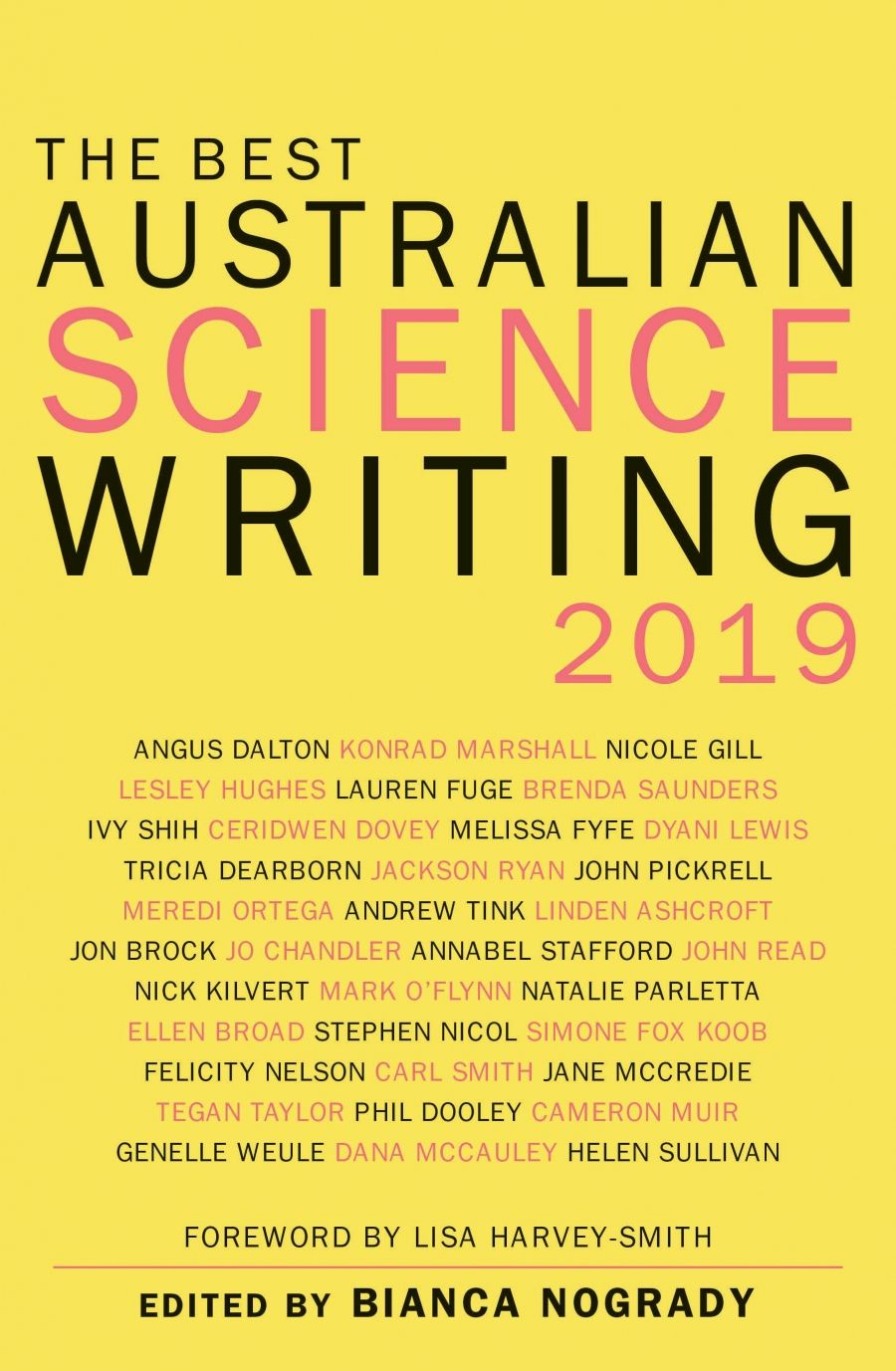
- Free Article: No
- Review Article: Yes
- Online Only: No
- Custom Highlight Text:
Reading good science writing is not just pleasurable and informative: it’s also necessary if we want to live engaged and examined lives in today’s hyper-technological, climate-changing world. The Best Australian Science Writing 2019 offers readers all these things – the delight in good writing, the satisfaction of learning, and the sobering reckoning with our society’s environmental impact and lack of political engagement with science. Yet it’s not afraid to challenge science itself on occasion – showing ‘its flaws as well as its finer moments’, as editor Bianca Nogrady puts it.
- Grid Image (300px * 250px):

- Book 1 Title: The Best Australian Science Writing 2019
- Book 1 Biblio: NewSouth, $29.99 pb, 320 pp, 9781742236407
One of the beauties of this anthology is that you engage with topics you’d normally pass over. For instance, I never thought I would ever become entranced by krill. But biologist Stephen Nicol weaves an enchanting story about the beauty and ecological importance of these fascinating creatures, the threats to their survival, and what it takes to study and understand them in their own habitat. This last point entails a critique of old-style biology, when ‘bugs’ were captured, killed, and studied back in the lab under a microscope, where ‘one krill body suspended in formalin looked much like the next’ and nothing was learned about their individual and group behaviour.
A number of other stories also involve critiques that show the complexity (and the humanness) of science and the way it is evolving. Jane McCredie shows the ill-informed nature of some reports and policy around foods that supposedly cause cancer, a refreshing change from the premature lifestyle and medical ‘breakthroughs’ that often dominate ‘science’ news. In the context of the academic pressure to ‘publish or perish’, and of the wastefulness of ‘sloppy science’ in commercial R&D, Jon Brock discusses the ‘replication crisis’ uncovered by C. Glenn Begley: the ‘growing recognition that many published findings cannot be reproduced by independent scientists, and may, therefore, be untrue’. It’s a dramatic wake-up call that Begley hopes will lead to (even) better science.
Similarly, Ellen Broad’s piece on a current philosophical debate around the application of machine learning emphasises a vital question: at what stage of development is there enough theoretical knowledge to safely proceed with new technologies?
Annabel Stafford’s discussion of the rise, fall, and rise of tuberculosis underlines the way cultural and economic attitudes have shaped people’s responses to illness; how our bodies are often treated differently, morally and practically, according to class and race.
Or gender: Melissa Fyfe’s delightful ‘Getting cliterate’ shows that it took a woman, Australian urologist Helen O’Connell, to discover the extraordinary anatomy of the clitoris. This led not only to the updating of textbooks, but put paid to Sigmund Freud’s pronouncements on the ‘immaturity’ of clitoral orgasms. A proper understanding of the anatomy shows that broadly speaking such orgasms are the only kind, as many women could have attested. O’Connell’s work has also paved the way for the same care to be taken of women’s sexuality as men’s during pelvic surgery.
Ceridwen Dovey explores gender issues, too, via the macho culture around space exploration. And the benefits of sharing Indigenous and Western knowledge are highlighted in John Pickrell’s piece on a newly discovered dinosaur ecosystem in Western Australia, and in Jo Chandler’s account of rare butterflies in Papua New Guinea. Barbara Saunders’s poignant poem brings to life the way Indigenous women ‘just out of Alice’ gather, prepare, and ‘pop under the tongue’ bush tobacco, a ‘remedy for sadness and fatigue’ far superior to the cigarette smoking taken up ‘in communities living “white way”’.
Nogrady’s introduction invites readers ‘to be transported, enlightened, delighted and hopeful, but we also need you to be angry. Because anger can inspire action, and right now that’s what we need most of all.’ She’s speaking of the environment, and ‘our collective grief for the world we are steadily destroying’. Indeed, Helen Sullivan describes the dire effects of the climate crisis on the Great Barrier Reef, as studied in a lab on Heron Island, where tanks containing miniature reefs are subjected to varying temperature and carbon dioxide levels. Cameron Muir shows that on ‘pristine’ Lord Howe Island, shearwaters ‘are slowly feeding their chicks to death with plastic’, thanks to the vast amount of debris discarded by humans in just a few decades. Fortunately, there’s good news, too, such as John Read’s article on an ingenious method of painlessly euthanising feral cats in the wild.
Other topics include gene editing in the egg industry to cull male chicks humanely, before they’re born; the politics of a sugar tax; a grim snapshot of Australia’s climate in 2040; the properties of sodium as a poetic metaphor; a proposal to send skilled writers and artists into space to convey the wonder of the universe that science has opened up; and more.
My only quibble is the choice of stories that offer little conceptual exposition. Understandably, given the planet’s dire state, there’s a predominance of nature writing, yet even the two chosen pieces by climate scientists (Linden Ashcroft and Lesley Hughes) use ‘soft’ – albeit intriguing – approaches. Overall, the collection made me wonder anew what it means to speak of the ‘best’ science writing. Is it simply the most accessible: the easiest to read, emphasising context rather than explaining important scientific concepts? Is it writing ‘about’ science, rather than ‘science writing’?
Still, the writing here is excellent. Collectively, it gives readers a feeling for both the fascination and the necessity of science, as well as for its limitations, and I enjoyed every piece.


Comments powered by CComment